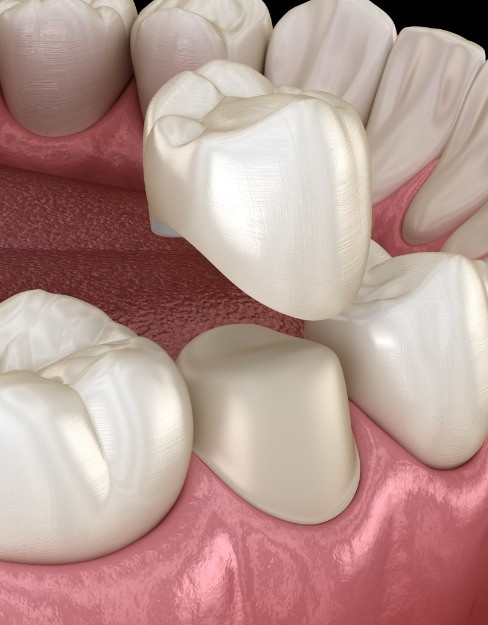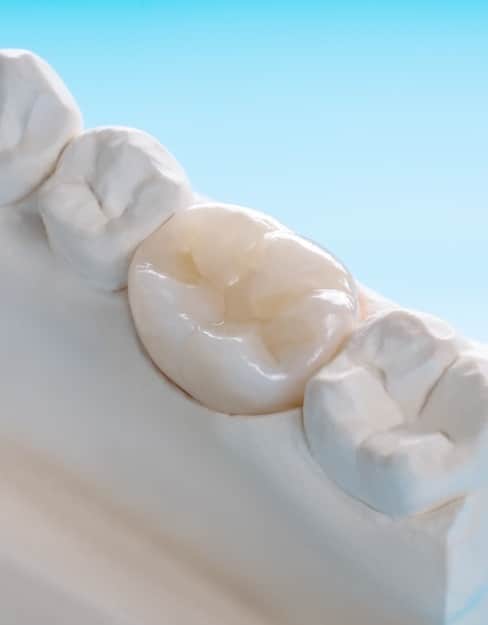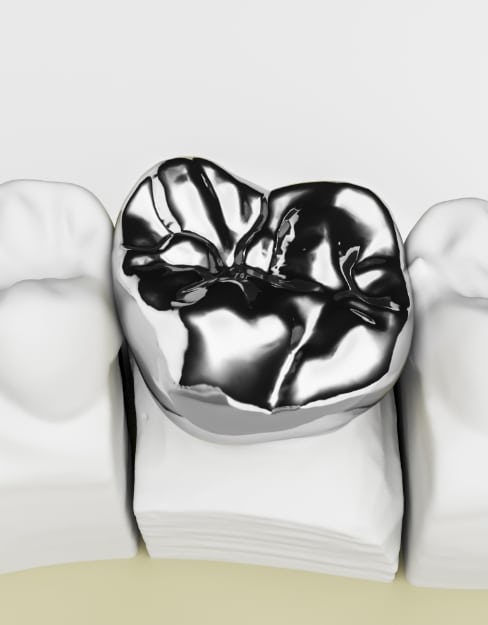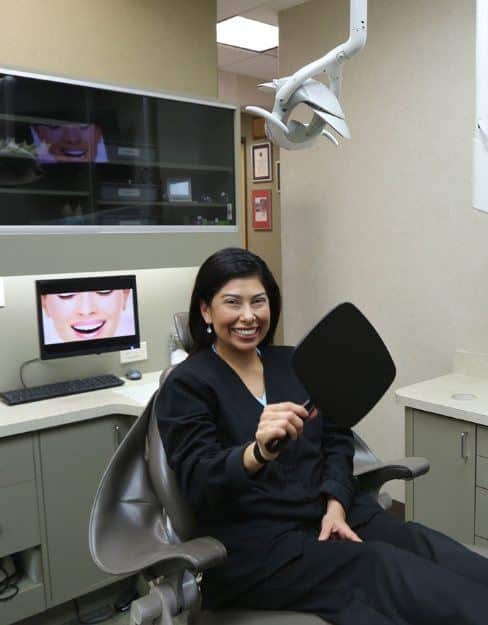Supporting Teeth with Custom-Crafted Dental Crowns
Dental crowns can restore a tooth’s function, shape, color, and beauty. Cavities, trauma, clenching, grinding, and large silver fillings often result in broken, chipped, discolored, or cracked teeth. A dental crown or porcelain veneer is a strong and durable restoration. At Roman Dental, Dr. Roman Kotlarek, a diplomate of the American Board of Aesthetic Dentistry, provides patients with beautiful dental crowns.

Why Choose Roman Dental for Dental Crowns?

High-Quality Dental Materials Used

Personalized, One-on-One Dentistry

We Accept Dental Insurance

What is a Dental Crown?
A dental crown (cap) restores a tooth’s strength, prevents fracture, and fortifies teeth with root canal treatment. Crowns may reduce tooth sensitivity and can be used to improve the appearance of teeth that are misshapen. In conjunction with dental implants and bridges, crowns are used to replace teeth and close gaps in the smile. Metal-free crowns are hard to detect and used in cosmetic dentistry as part of a smile makeover. Crowns can be made of different materials; choosing the “right” material will create the naturally beautiful smile that’s just as healthy as it is natural-looking.
All-Ceramic Dental Crowns/ Metal-Free Dental Crowns
Ceramic crowns are made entirely of tooth-colored material. There are many brand names (Lava, Ivoclar Empress, E-max, Belle Glass, BruxZir) and different materials (zirconia, lithium disilicate, and feldspathic porcelain) used to make all-ceramic crowns. These crowns are made of beautiful tooth-colored porcelain that is amazingly natural-looking. Unlike porcelain fused to metal crowns, light can travel through these crowns, making them look natural in indoor and outdoor lighting.
Additionally, some of the all-ceramic systems employ a technology that produces a more accurate duplication of the dentist’s preparations; this ultimately creates a better fit and gum-line contour. These crowns are free of base metals nickel, chromium, and molybdenum iron,

which are known to cause irritation and gum swelling. All-ceramic crowns are the best choice when appearance and gum health are primary concerns.

Porcelain Fused to Metal Crowns
A benefit of Porcelain fused to metal crowns is rigid strength. However, dentists are required to make room for the layer of metal by removing more tooth structure than is required with other types of crowns. Porcelain fused to metal dental crowns are not considered the most aesthetic; it can have an opaque appearance called the “headlight effect” when used on the front teeth.
Porcelain fused to metal crowns are strong and durable. Tooth-colored porcelain is layered on top of a thin coating of metal; this layer of porcelain hides beneath the metal. Different metals (non-precious nickel/chrome, titanium, or gold alloys) can be used under the porcelain. Patients can experience metal allergy and gum inflammation with non-precious metal crowns.
The non-precious metal is grey in color and may create darkness where the gum and crown meet. These crowns tend to be very “bright” due to the opaque porcelain used to hide the color of the underlying metal.
Full Metal Dental Crowns
Full metal crowns are strong, thin, and durable. Full gold crowns have a few benefits; they require minimal tooth structure removal, provide superior gum health, are non-abrasive, are recurrent decay-resistant, are long-lasting, and rarely create post-operative sensitivity. These crowns can be an excellent option in areas of the mouth where strength and longevity are the primary concern.


Dental Crown Frequently Asked Questions
Do you have questions about the process of getting a dental crown, materials these restorations can be made from, or how long they last? Below, we’ve compiled some of the most common questions we receive from our patients for your convenience. If you don’t see the information you need, please don’t hesitate to reach out to us directly.
A crown is a dental restoration that wraps around or “caps” a tooth that needs repair.
When a tooth is badly decayed, chipped, poorly shaped, or positioned, a dental crown may be the best option to predictably restore the tooth’s strength, function, and beauty.
Generally, a filling is the first choice to repair a sensitive, chipped, or decayed tooth. However, a large filling may further weaken a tooth, causing the tooth to crack. Unfortunately, tooth removal (extraction) is often the only option after a tooth has cracked at or beneath the gum level. Through training and experience, Dentists evaluate the condition of a tooth and recommend treatment, possibly a crown, so that the dental repair will maintain the tooth’s integrity throughout the patient’s lifetime. By design, crowns strengthen teeth. Crowns, by preventing root fracture, save teeth that would otherwise require eventual root canal treatment or extraction.
Root canal therapy eliminates nervous tissue, blood, and lymphatic flow through a tooth. Blood flow nourishes and keeps tooth structure strong and resilient. A tooth without blood flow, like a tree without water, will become weak. Crown placement will strengthen the “root-canaled” tooth and prevent it from breaking.
Crowns often are made in layers, an outside layer (white porcelain) and an inner layer (grey metalcore). The crown is often fragile at the gum level, and the grey cast shows through the thin layer of porcelain. This grey color is initially hidden under the gum tissue in a crevice called the periodontal pocket that exists around all teeth. If the gum tissue recedes down the tooth root, the thin grey edge of the crown is revealed. This exposure may reveal an unsightly blue or grey color at the gum level.
Yes, the black line at the edge of your crown can be eliminated. Typically, the crown is replaced, and the discoloration vanishes. If the gum line darkness results from a discolored tooth root rather than a discolored crown, other treatments will be needed.
Yes, a crown can be made with a white (tooth-colored) inner layer. If the gum recedes, the exposed edge will be less visible because of the inner layer’s natural coloration. Dentists can now provide metal-free crowns. The solid tooth-colored material, called zirconia or lithium disilicate, is more esthetic, requires less tooth structure removal, and is healthier for the gum tissue.
Gold (metal) crowns can be made very thin without any risk of breakage. Porcelain (tooth-colored) crowns conversely require a minimum thickness to develop strength and resistance to fracture. The issue of crown thickness is significant. The crown thickness is the minimum dimension that must be removed from the natural tooth for it to return to its original size following crown placement. Some types of all-ceramic and porcelain fused to metal crowns require three times tooth reduction versus a full gold crown. If the tooth to be crowned has limited height (the distance from the gum line to the top of the tooth), placement of a metal crown leaves behind more tooth structure. Increasing the remaining tooth structure makes the tooth less likely to require root canal therapy and lessens the chance of a crown becoming loose. Additionally, metal crowns may be suggested because they are non-abrasive and will not wear away from the natural teeth they may touch during chewing.
Sensitivity following crown placement is not uncommon. Sensitivity occurs because deep cavities, unrecognized fractures, and irritation from dental materials and treatments cause the soft tissue that lives within a tooth’s center to become swollen. In severe, lingering, thermal, pressure, or spontaneous pain, therapy of the root canal system may be required. Typically, the sensitivity will naturally diminish in 1-4 days following crown placement. Occasionally, sensitivity gradually resolves over many months. If sensitivity worsens or does not improve, return to the dentist for follow-up evaluation and care. Often, an adjustment of the bite will reduce the sensitivity.
Yes, a very thin crown that is colored like a natural tooth is now available. The crown is made of a material called zirconia. BruxZir is a popular brand name for this type of zirconia crown. BruxZir crowns can be very thin, yet strong and resistant to breaking. In most cases, a zirconia crown can substitute for a gold crown. Zirconia crowns require your dentist to reduce slightly more natural tooth structure, and they are more susceptible to becoming loose and needing to be re-cemented. However, zirconia crowns are white (tooth-colored), strong, and like gold crowns, do not promote gum inflammation and bleeding that commonly occurs around crowns made with non-precious metal alternatives.
On average, dental crowns can last 10 to 15 years or longer. Their longevity depends on factors like the material used, oral hygiene, and lifestyle habits.
Porcelain or ceramic crowns tend to have a shorter lifespan compared to metal or zirconia crowns. Proper care, such as daily brushing, flossing, and regular dental checkups, can also extend the life of a crown.
A crown itself cannot get cavities because it’s made from materials like porcelain or metal. However, the tooth underneath it can still decay.
Bacteria can accumulate at the margin where the crown meets the tooth. This may lead to decay if the patient does not maintain good oral hygiene. Regular dental cleanings and at-home care are essential to preventing cavities around the crown.
Once the dental crown has been fully set and adjusted, you can eat normally. However, it’s recommended to avoid very hard or sticky foods, especially in the first few days after placement.
Biting down on hard substances like ice or hard candy could damage the crown or loosen it from the tooth. Softer foods are advised initially, but normal eating habits can resume once you are comfortable.
Most dental crowns, especially those made from porcelain or ceramic, are more stain-resistant than natural teeth. However, they are not completely immune to staining.
Dark-colored foods and drinks (coffee, wine, berries, etc.) can lead to surface discoloration over time. Maintaining good oral hygiene and limiting stain-causing substances can help keep the crown looking its best.
If a dental crown falls off, contact Dr. Roman immediately. It may not always cause immediate pain. However, the underlying tooth can become sensitive or prone to damage.
Keep the crown safe, as it may be possible for Dr. Roman to reattach it. In the meantime, don’t chew on the affected side. You may also want to use over-the-counter dental cement to secure it temporarily.
Why Choose Roman Dental?
At Roman Dental, we are dedicated to helping patients maintain healthy and attractive smiles that last a lifetime. Led by Dr. Roman Kotlarek, a detail-oriented and comfort-focused dentist, our practice provides comprehensive dental care under one roof.
We take pride in offering personalized, high-quality dental crowns and a wide range of other services. We also ensure that every patient’s needs are met efficiently and comfortably. Our team is passionate about patient satisfaction and long-term dental health, making Roman Dental an excellent choice for anyone seeking superior care.
Schedule a Consultation in West Houston
Dental crowns are a durable, effective solution for restoring damaged or discolored teeth. At Roman Dental, Dr. Roman Kotlarek combines expertise and a patient-focused approach to deliver crowns designed to last.
Schedule a consultation at our West Houston office to explore how dental crowns can enhance your smile and overall dental health. Call us at (281) 920-4200 or request an appointment online.








